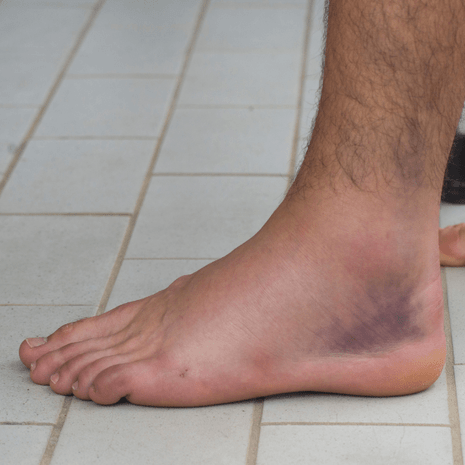Chronic Ankle Instability Treatment
at Foot Foundation
If your ankle keeps “giving way,” it may be chronic ankle instability from repeated sprains.
At Foot Foundation, we provide specialist care combining strengthening, balance training, orthotics, and rehabilitation to restore confidence and prevent further sprains.
What is Chronic Ankle Instability?
Chronic ankle instability (CAI) is a condition where the ankle repeatedly “gives way” following one or more ankle sprains. It results from a combination of ligament laxity, proprioceptive deficits, and muscular weakness, leading to recurrent sprains, persistent instability, and long-term joint changes.
Without specialist care, CAI can progress to early ankle arthritis, cartilage injury (osteochondral lesions), and permanent loss of stability.
At Foot Foundation, we provide specialist-level assessment and rehabilitation for CAI, addressing both the structural ligament damage and the neuromuscular deficits that cause ongoing problems.
Causes & Risk Factors
History of ankle sprains (most common cause)
Incomplete or poor rehabilitation following an acute sprain
Generalised ligament laxity or hypermobility
Weak peroneal muscles or poor balance
Foot and ankle biomechanics (excessive pronation, cavus foot)
High-risk sports (netball, basketball, football, rugby, trail running)
Poor footwear lacking lateral support
Walking or training on uneven ground
Treatment at Foot Foundation
Balance and proprioception training – essential for restoring joint control
Strengthening programs – peroneals, calf, and intrinsic foot muscles
Custom orthotics – improve biomechanics and reduce recurrence risk
Functional bracing or strapping – for short-term support in sport
Manual therapy – mobilisation and soft tissue release
Shockwave therapy – in cases of chronic ligament pain or scar tissue
Return-to-sport rehabilitation – progressive, sport-specific drills
Referral to orthopaedics – if surgical ligament reconstruction is required in severe cases
Symptoms
Recurrent ankle sprains, often during sport or daily activity
Sensation of ankle “giving way” or instability
Ongoing ankle pain, swelling, or stiffness after activity
Difficulty with balance and uneven surfaces
Reduced confidence in ankle stability, leading to activity avoidance
Diagnosis
At Foot Foundation, diagnosis is made through:
Detailed injury history (number of sprains, mechanism of injury)
Ligament stability testing (ATFL, CFL, PTFL)
Functional strength and balance testing
Gait and biomechanical assessment
Ultrasound or MRI if structural damage or cartilage injury is suspected
Chronic Ankle Instability – FAQs
It is a condition where the ankle repeatedly gives way after sprains. It occurs due to ligament laxity, weakness, and impaired balance, leaving the joint vulnerable to further injury.
The most common reason is chronic ankle instability. If ligaments heal in a lengthened or weakened state and rehabilitation is incomplete, the ankle loses its ability to stabilise properly.
A sprain is an acute ligament injury, while chronic instability is a long-term condition involving structural weakness and impaired neuromuscular control.
Yes. If untreated, CAI increases the risk of:
- Recurrent sprains
- Osteochondral lesions (cartilage damage inside the ankle joint)
- Ankle arthritis due to repetitive joint trauma
With structured rehabilitation, many patients improve within 8–12 weeks. Severe or longstanding instability may take longer, and some cases may require surgical repair.
The most effective treatments are:
- Proprioceptive and balance training
- Strengthening of the ankle stabilisers (especially peroneal muscles)
- Orthotics to correct biomechanics
- Functional bracing during high-risk activity
Yes. Orthotics reduce abnormal movement patterns, control excessive pronation or supination, and improve stability — particularly when combined with strengthening programs.
Most patients respond well to conservative treatment. Surgery (ligament reconstruction) is considered if instability persists despite rehabilitation or if there is severe ligament rupture with mechanical laxity.
Yes, but only with correct management. Functional bracing, strapping, and a graded return-to-sport rehabilitation plan reduce the risk of further injury.
If your ankle “gives way” frequently, or if you’ve had two or more sprains in a year, you should seek specialist care. Early intervention prevents long-term complications such as arthritis.
Why Choose Foot Foundation?
Foot Foundation provides specialist care for chronic ankle instability, addressing both ligament damage and neuromuscular deficits. Our expert podiatrists and physiotherapists design tailored rehabilitation programs, prescribe orthotics, and use advanced therapies to restore stability and confidence.
With clinics in Rosedale, Takapuna, Remuera, Botany, Hamilton, and Tauranga, Foot Foundation offers expert ankle rehabilitation across New Zealand.




